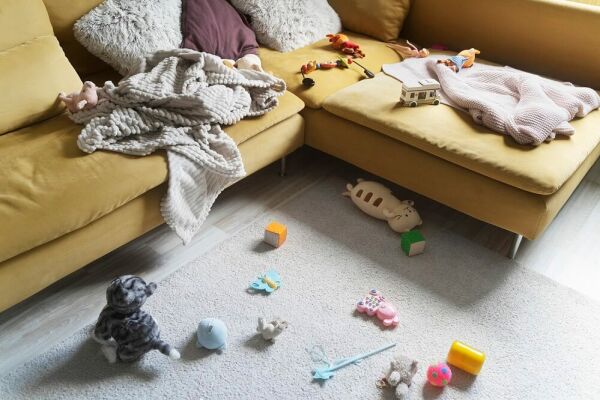Under ideal circumstances, your home office would be a dedicated room with a proper desk, an ergonomically correct chair, great lighting, and a door you can close at the end of the day. In reality, as people across the country continue working from home to prevent the spread of novel coronavirus (COVID-19), most of us are dealing with decidedly less-than-ideal conditions. Instead of a separate space, our “home offices” might look more like a small clearing on a cluttered kitchen table or a makeshift workspace in a shared room that was never intended for focused work or video conferences.
If you already have an office-like space where you pay bills, manage the household, and take care of other simple tasks, you might be able to repurpose this space temporarily for full-time work. However, chances are this space wasn’t designed with work in mind, and you will undoubtedly encounter some challenges along the way, including:
- Inadequate tech that wasn’t intended to be use for full-time work, such as old laptops, antiquated desktop computers, or cheap webcams
- Family members in the home ready to distract you from your work or make an embarrassing appearance on your next video call, including partners who may also be working from home, kids attempting to learn at home, and pets
- Roommates that you have no control over
- Multiple people vying for the same workspaces and internet connection
In addition to the stress and anxiety that accompany a global viral pandemic, these challenging conditions can add up to a serious loss in productivity. The good news is that a lot of people are in the same boat. No one expects perfection or peak work-output, and we can all count on a few snafus along the way.
If you’re feeling the pinch at your new home office, remember that this is temporary. While you will eventually return to your old office stomping grounds, it’s hard to predict when that will be. You may need to make use of your new home office for months to come, so it’s worth taking the time to make it comfortable and ensure your space enables you to get your job done optimally for the time being.
Here’s how you can set up a productive temporary home office in three easy steps:
1. Select a dedicated work space
Rooms that are infrequently used are good candidates for temporary home offices. If possible, find somewhere quiet with privacy, such as a spare room or a den.
Not all of us have the space to devote a dedicated room to remote work. If space is limited, do your best to avoid working from your bed or couch, and choose a designated workstation within your house, such as one seat at your dining room table. Work from this space consistently and exclusively. Use headphones and listen to music, white noise tracks, or whatever helps you concentrate to create the illusion of privacy in shared spaces.
If you miss the social aspect of your usual work environment, sharing a workspace with others in your home might provide some much-needed socialization. Carey Chesney from Rocket Homes offers this advice for choosing a temporary workspace:
As long as you don’t distract each other too much, working together, either in a home office or another makeshift workspace, can help you feel less lonely and more like you’re in an office environment. But if one of you has a job that requires lots of focus and the other’s job requires a ton of phone calls and video conferences, it’s probably best to find separate spaces of the shouse to conduct business.
TSI TIP: Wherever you settle down, set up your temporary home office the same as your normal office. Use the same supplies, follow the same routines, and wear the same clothes if it helps you stay productive.
2. Get your lighting right
Good lighting is essential to preventing eye strain and maintaining your productivity.
If possible, situate your workspace near a window or other natural light exposure. Natural lighting is especially ideal for improving mood and productivity, particularly while practicing physical distancing and limiting your outdoor time. If your makeshift home office doesn’t offer access to natural light, look into replacing your lighting with full-spectrum cool white or daylight-colored light bulbs to promote productivity.
TSI TIP: Combine natural and overhead lighting with dedicated task lighting to make it easier to concentrate up close. Try to position yourself so that any nearby windows are located to the side of your computer screen rather than in front of or behind you to avoid glare and other visibility issues.
3. Collect essential home office supplies and equipment
Once you’ve chosen a space, you can start to collect the necessary supplies and equipment. Here’s what you’ll need to set up a home office:
- Desk: A dedicated desk is always ideal, but a kitchen or dining room table, eat-in kitchen counter, or any large, flat surface will work.
- Chair: Adjustable office chairs are the best option for comfort and ergonomics, but most of us won’t be able to take our chairs from work or drop a couple hundred dollars on a new desk chair to get through the next few weeks or months. Choose the chair that offers the best support in your household, and use pillows and other padding to make it work in the short-term. If your feet can’t touch the ground, stack some books or pillows under your feet to provide support.
- Computer: A capable computer is key to maintaining productivity at home. Some workplaces have sent employees home with laptops and other devices, while others are asking employees to use their personal devices. If you’re using a personal device that might not be up to the task, do your best with what you have, and take comfort in the fact that a lot of people are dealing with similar deficiencies.
- Monitor: Laptops are built to be portable, and there’s a good chance that yours will be too small to handle the day-to-day activities required by your job. A second monitor that extends your laptop screen using an HDMI cable can be a huge productivity booster.
- High speed internet: You may need to temporarily boost your internet service plan to ensure that you have the speed you need to work effectively while everyone else is at home and sharing the same connection.
- Webcam and microphone: You’ll probably be having a lot of conference calls over the coming weeks, especially if your team doesn’t work remotely very often. A decent webcam and microphone are essential to a smooth conference call experience.
- Office supplies: Collect writing utensils, a notebook to track your activities, and other necessary office supplies before you start working and keep them within reach of your workstation to minimize distractions.
- Storage: A box or two to contain your office supplies during non-work hours can help you stay organized while you’re on the clock, as well as mentally disconnect at the end of the day.
BONUS: While they aren’t essential, placing a few houseplants around your workspace can help improve your productivity—some studies have shown that workers are 15% more productive in places that contain indoor plants.
7 Tips for Staying Productive Working from Home
Now that your office is set up, it’s time to get down to business. Stay productive with these tips:
- Find a dedicated spot for personal electronics. Without a manager or supervisor keeping an eye, it’s easy to get distracted by your cell phone and other gadgets. Storing these devices away from your immediate work area can discourage distraction and help you stay focused.
- Separate work and personal digital profiles on personal devices. Install only work-related apps and tools on your work profile to make it easier to avoid distraction during the day. Use your personal account during off-work hours to avoid the temptation to check your emails during your personal time.
- Create a new routine. If you normally work 9-5, try to work 9-5 at home as well to maintain your routine as much as possible. Making a schedule for your day, including personal tasks like errands or hobbies, can also help you settle into a routine and not feel so confined.
- Set your work hours. When you work from home, it’s easy to lose track of time and work well into your personal time. Sometimes resisting the urge to polish off a half-finished project on a Saturday afternoon can feel overpoweringly difficult. Don’t let your work-self suffocate your life-self—do your best to stick to your set work hours, and try to avoid working outside of these hours to create separation.
- Take breaks. Workers in a home office are more likely to overwork than those in traditional workspaces. Make sure you take breaks throughout the day to keep your mind fresh. Just be mindful that your break doesn’t stretch too long—that unfolded pile of laundry can be a tempting distraction that might actually harm your productivity.
- Set boundaries. Communicate your needs to your family and anyone else living in your household. Establish an open dialogue to help everyone set clear working hours and avoid distractions. Set boundaries with yourself as well: “When you’re working from home, the line between ‘work’ and ‘home’ can get really fuzzy. If you’re able to, try to stick to the schedule you’d keep in the office. Once you’re done for the day, put away your work gear and do something to relax,” suggests Chesney.
- Declutter your workspace. Clutter decreases productivity and makes it harder to pack up and disconnect. Decluttering can be especially difficult in temporary workspaces where you don’t have the storage to put everything away at the end of the day. If you can, purchase organization supplies online to temporarily corral clutter and free up your workspace. Better yet, repurpose items you have around your home already, such as decorative baskets, plastic bins, or even the box from your latest online delivery.
- Get dressed for work. “While comfy clothes can be great for lounging around the house, they don’t exactly put you in a working mindset”, advises Chesney. “Spending some time in the morning getting ready can make a huge impact [...] even if it’s just putting your hair in a ponytail and putting on your ‘nice’ pair of sweats”.
Conclusion
While many businesses have been embracing remote work for years, the emergence of novel coronavirus (COVID-19) has inspired many more to enable their employees to work from home. Between lack of space, a full household, and the change in routine, creating a productive, temporary home office can be a challenge. Follow these three steps to make it as simple as possible:
- Select a dedicated work space
- Get your lighting right
- Make sure you have essential home office supplies and equipment
Once you’ve set up you workspace, stay productive by:
- Finding a dedicated spot for personal electronics
- Creating a new routine
- Setting work hours
- Taking breaks
- Setting boundaries
- Decluttering your workspace
Get more tips for organizing your home with our organization series.
Read our newest emergency preparedness resources for more advice on how to prepare for COVID-19.




